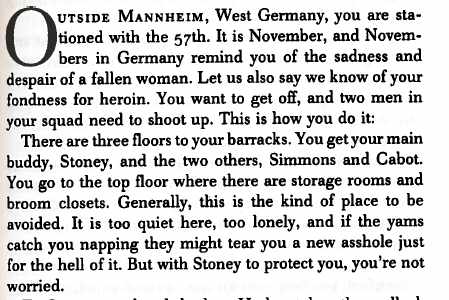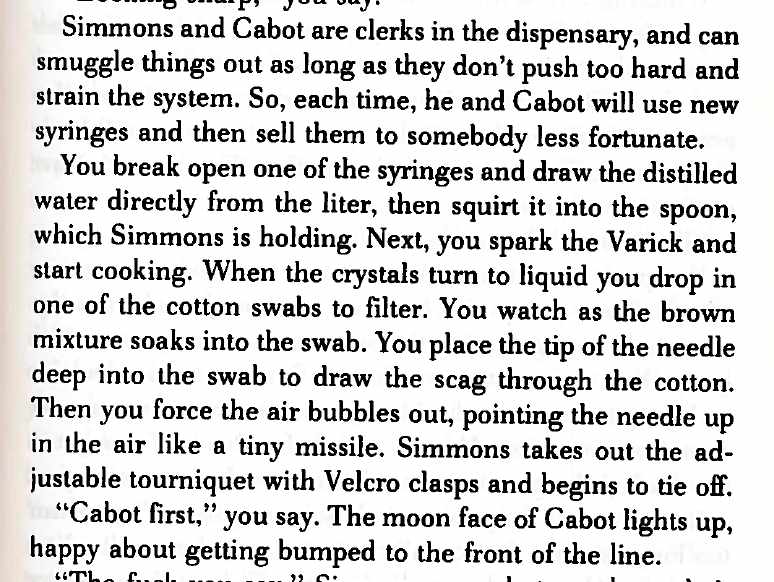Title of Work and its Form: Buffalo Soldiers, novel
Author: Robert O’Connor
Date of Work: 1992
Where the Work Can Be Found: The book was published by Vintage and can be purchased at all fine local bookstores, including Oswego, New York’s River’s End Bookstore. Or from Amazon. Or Powell’s. Just buy it.
Bonuses: Why not check out the New York Times review of the book? The novel was also adapted into a film starring Ed Harris and Joaquin Phoenix. Here’s the trailer.
Element of Craft We’re Stealing: Description
Discussion:
Specialist Ray Elwood is an Army man stationed in Germany, but he’s not the kind of soldier you see in the recruiting posters. Elwood uses and sells drugs and works in Colonel Berman’s office, writing letters and helping the colonel write scholarly articles about the art of war. You have to grease a lot of palms and out-think a lot of people if you’re in Elwood’s line of business, and he’s always a step ahead. Even when a new Top arrives. Sergeant Lee doesn’t like Elwood very much; as a former drug user, he can see right through Elwood’s façade. Sergeant Lee also has a beautiful young daughter, Robyn, who has lost most of an arm for reasons I won’t divulge. As you might expect, Elwood’s situation deteriorates through the novel and Elwood has new and greater dragons to slay. The first three-quarters of the book is a page turner; the last quarter is a breathless race to an inevitable conclusion. Re-reading this summary, you might not realize the book is a dark and powerful comedy that is grounded in real human emotion.
Mr. O’Connor happened to be one of my teachers at Oswego State. (To my great honor, he’s currently one of my colleagues in the Creative Writing Department.) One of the many reasons he’s a strong teacher is that he offers customized advice to each student in the service of honoring the student’s literary goals above all. This is a policy that was also held by my great teachers at Ohio State, and a goal I have today in my own teaching. You want to write an experimental thriller starring an anthropomorphic stapler? That is not at all the style of fiction that I personally enjoy, but great. Let’s make this the best killer stapler story we can. You have a sentimental and sincere love story in mind? That’s not my bag, but what can we do to make this the sweetest and least complicated love story possible.
I have no idea how many students do what I did each time I had a new writing teacher: I got one of his or her books or read some of his or her stories. (Or plays.) You may not wish to write a book like Buffalo Soldiers, for example, but you can tell immediately that Mr. O’Connor is a master of description and excellent at maintaining narrative momentum. Understanding his work allows you to ask more specific questions and to interact in a more meaningful manner. It’s also a lot of fun to talk to writers about their work. I remember having a question about one of Erin McGraw’s sentences when I read it…as her student, I was welcome to e-mail her and ask her specific questions about her craft! (Most writing teachers love talking to students, don’cha know.) Think about it in another, less scholarly way. Can it really hurt you if your teacher sees you walking around with a copy of his or her book? (Especially if it’s not from the library!)
Okay. Let’s get to the lessons you can steal specifically from Buffalo Soldiers and not just its author. I have to acknowledge the elephant in the critical room. Many folks have heaped laurels upon Mr. O’Connor because of the way he used the second person in his book. (I may be wrong, but it seems as though this point of view has been used more since the Buffalo Soldiers/Bright Lights, Big City era.)
One of the primary advantages of a second-person POV is that you’re explicitly forcing the reader into sympathizing with your character. Check out the very beginning of the book:
Mr. O’Connor accomplishes a lot with the first two paragraphs:
- The first sentence establishes the second person POV.
- You learn that Ray Elwood (the protagonist) is in the military and is stationed in Germany.
- You learn that Ray is not exactly a happy man.
- You find out that Ray enjoys heroin and is the leader when it comes to helping others use the drug.
- You discover that Stoney is the muscle in the group.
- It’s immediately clear that Ray likes to break the rules and knows how to work around them.
So Mr. O’Connor does indeed help you relate to Ray with the use of the second person POV. More importantly, the POV creates a more visceral understanding of some “extreme” actions. How many of us know what it’s like to cook and shoot heroin? When you read the book, “you” do. I’m wagering that few folks who read this know what it’s like to patronize a German brothel. Well, through the use of the second person, “you” do. The decreased narrative distance between the reader and Ray helps bridge the gap between them and makes some dangerous and exotic plot developments seem a lot more normal. If the book were in the first person, some readers may have been more judgmental of Ray’s actions as Ray tried to explain himself to the reader. In the third-person, the narrator may have seemed very far away from a character who, on some level, just wants others to understand him.
Mr. O’Connor also provides a master class in description. I hate needles…the narration of the drug use scenes made me just as uncomfortable as if I were in a doctor’s office to get a tetanus booster. One of the characters decides to get circumcised; the description made me shift in my chair as I read. Look at the way Mr. O’Connor describes the cooking of heroin, a procedure with which many readers may be unfamiliar:
His sentences are short and relatively simple. There are plenty of complicated and beautiful sentences in the book, but Mr. O’Connor doesn’t employ them here. Mr. O’Connor wows you with his ability to make music with words, but ensures that he is very clear as to what a heroin user does with the cotton balls.
I won’t spoil the ending, but it’s stellar. It’s no surprise that Ray gets himself into some big trouble. Mr. O’Connor sticks the landing, so to speak. The ending addresses all of the conflicts that he has introduced during the course of the book. In the space of a few pages, all of the book’s questions are resolved. Even better, the promise of the character of Ray Elwood is fulfilled.
What Should We Steal?
- Read the work that has been produced by your teachers and be open to all kinds of mentors. On one hand, it may be great for a pure mystery writer to work closely with a teacher who only writes mysteries. On the other hand, lots of great teachers work, teach and/or write in all genres and their primary goal is to help you with your specific story.
- Employ second person to help your reader feel experiences that are alien to them. The second person knocks down some of the barriers between the reader and characters who may be engaged in unusual or unexpected activities.
- Provide lush and simple descriptions for exotic actions. Your reader may not know what it’s like to speed down the Autobahn or to take a tank for a joyride. Ensure that you describe such actions in simple and powerful terms. (You know…if you have access to a tank, I would love to find out what it’s like to go for a joyride in the first person.)
- Concoct a conclusion that connects all of the questions you’ve contrived. The ending of a novel (or a song or short story or nonfiction piece) is like the blossoming of a flower. You have planted and pruned and fertilized…now it’s time to enjoy the logical end of all of your labor.



Keep history alive and well by telling that history:
Read the epic novel, “Rescue at Pine Ridge”, where Buffalo Bill Cody meets a Buffalo Soldier, the greatest epic ‘novel’ ever written. A great story of Black Military History, the first generation of Buffalo Soldiers…5 stars Amazon internationally, and Barnes & Noble. The website is; http://www.rescueatpineridge.com Youtube commercials are: http://www.youtube.com/watch?v=xEgEqgNi2Is and
http://www.youtube.com/watch?v=jVslyHmDy9A&feature=related
Rescue at Pine Ridge is the epic story of the 9th Cavalry from its Congressional conception in 1866, to the rescue of the famed 7th Cavalry by the 9th Cavalry Buffalo Soldiers, 1890. The 7th Cavalry was entrapped again after the Little Big Horn Massacre, fourteen years later, the day after the Wounded Knee Massacre. If it wasn’t for the 9th Cavalry Buffalo Soldiers, there would of occurred, a second massacre of the 7th Cavalry. This story is about, brutality, compassion, bravery, gallantry, reprisal, heroism and redemption.
I know you’ll enjoy the novel. I wrote the story that embodied the Native Americans, Outlaws and African-American/Black Soldiers, from the east to the west, from the south to the north, in the days of the Native American Wars with the approaching United States of America.
The novel was taken from my mini-series movie with the same title, “RaPR” to keep the story alive. The movie so far has the interest of major actors in which we are in talks with, in starring in this epic American story.
When you get a chance, also please visit our Alpha Wolf Production website at; http://www.alphawolfprods.com and see our other productions, like Stagecoach Mary, the first Black Woman to deliver mail for the United States Postal System in Montana, in the 1890’s, “spread the word”.
Peace.